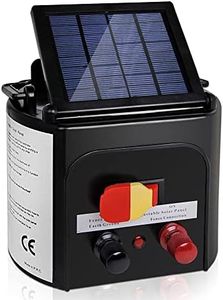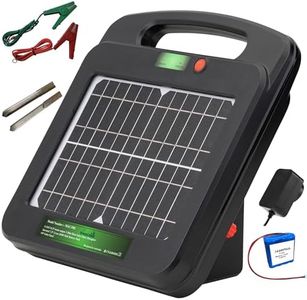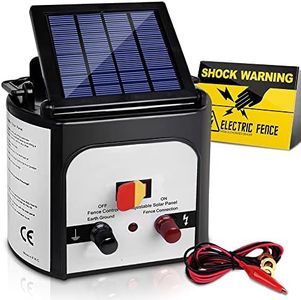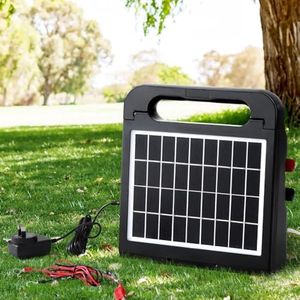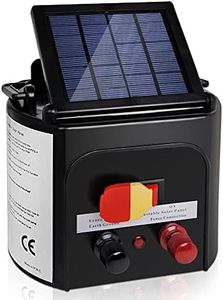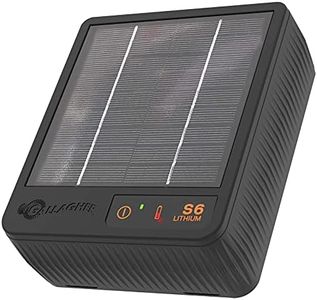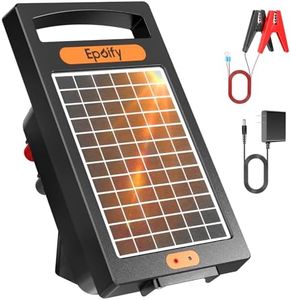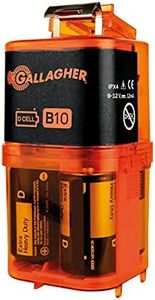We Use CookiesWe use cookies to enhance the security, performance,
functionality and for analytical and promotional activities. By continuing to browse this site you
are agreeing to our privacy policy
10 Best Solar Powered Fence Charger
From leading brands and best sellers available on the web.Buying Guide for the Best Solar Powered Fence Charger
Choosing a solar-powered fence charger means you’re seeking a way to keep your electric fence running smoothly using energy from the sun. The right charger helps provide consistent power to your fence—even in remote locations—while being environmentally friendly and low maintenance. Picking the best fit involves understanding specific features and how they will match your fencing needs, your local environment, and the type of animals you want to contain or keep out. Here’s how to work through the most important specifications.Output VoltageOutput voltage refers to the electrical force the charger delivers to the fence. It’s important because it determines how effective the fence is at deterring or containing animals. Lower voltages (around 2,000-4,000 volts) are suitable for small or domesticated animals such as pets or livestock like sheep. Medium voltages (4,000-6,000 volts) work for larger animals like cattle or horses. Higher voltages (over 6,000 volts) are often needed for more stubborn animals or for predator exclusion. Choose the voltage based on the animals and the sensitivity of your fencing needs.
Joule RatingJoule rating tells you how much energy the charger can deliver per pulse. This affects how strong and long the shock feels. Low joule chargers (up to 1 joule) are intended for short fences and minor containment needs. Medium ratings (1-5 joules) are better for longer fences or slightly tougher animals. High joule ratings (over 5 joules) are needed for very large fences, wild animals, or more heavy-duty containment. Match the joule rating to the size of your fence and the temperament of the animals involved.
Miles of Fence CoveredMiles of fence covered estimates the total length of wire the charger can handle. Short-range chargers may only cover 1-5 miles and are suitable for small areas or gardens. Mid-range models may cover 5-20 miles, which fits standard pasture sizes or multi-animal setups. Long-range chargers can cover over 20 miles, required for very large properties or multiple connected fence lines. Always consider the type of vegetation, wire, and fence condition—more weeds and poor wire reduce the effective distance.
Solar Panel WattageThe solar panel wattage indicates how much solar energy the charger can collect and use. Lower wattage (1-3 watts) works in areas with lots of sun and for small or intermittent use. Medium wattage (5-10 watts) gives a buffer for cloudy days and suits regular use. Higher wattage (over 10 watts) is best for large setups or for regions with less consistent sunshine. Pick wattage based on your sunlight conditions and how frequently you expect the charger to need a full power supply.
Battery CapacityBattery capacity tells you how much reserve energy the charger has when there’s no sun. Smaller batteries may provide power for a couple of nights, making them suitable for sunny areas or light use. Medium capacities keep the system powered for several days or through regular cloudy periods. Larger batteries offer more peace of mind for variable weather or remote locations. Choose a battery size based on how reliable your sunlight is and how critical uninterrupted operation is to you.
Weatherproofing and DurabilityWeatherproofing refers to how well the charger can withstand rain, dust, and temperature swings. Durable models will last longer outdoors without failing, which is important if you plan to install the charger permanently or in rough environments. Basic weather resistance may suffice in mild, dry climates, but look for more robust features like sealed housings and UV protection in harsher conditions. Your local weather should guide your choice.
Indicator Lights and ControlsIndicator lights and easy-to-use controls make it simpler to monitor the charger’s performance and troubleshoot any problems. Basic units might have a single light to show power status, while more advanced ones offer diagnostics. If you prefer a set-and-forget solution, a simple indicator may be enough, but if you value active control and rapid problem detection, choose a model with multiple indicators and user-friendly controls.
